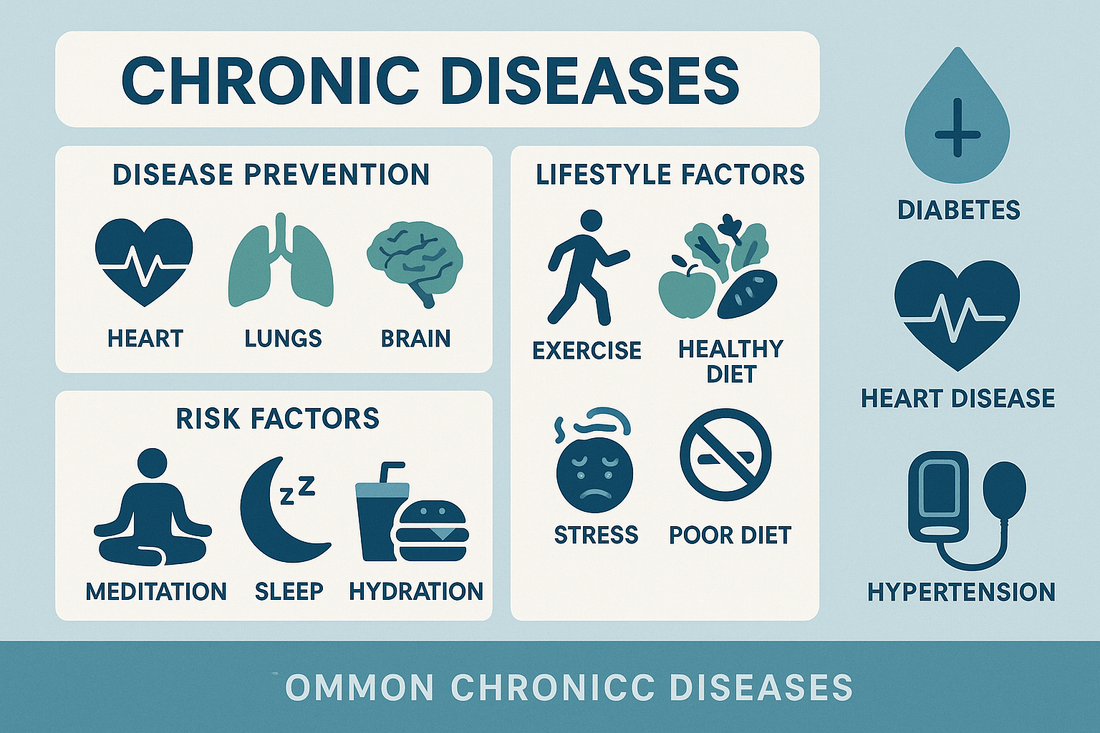
Understanding Chronic Diseases: Causes, Prevention, and How to Live Healthier
Share
Chronic diseases are among the leading causes of illness and death worldwide but what’s often overlooked is that most of them can be prevented or managed through lifestyle choices.
From heart disease and diabetes to hypertension and arthritis, chronic illnesses can impact every aspect of life. The good news? With the right habits, knowledge, and support, you can take control of your health and dramatically improve your quality of life.
What Are Chronic Diseases?
Chronic diseases (also called non-communicable diseases) are long-term health conditions that progress slowly and often last for years — or even a lifetime. Unlike infections, they usually develop due to a mix of genetic, lifestyle, and environmental factors.
Common Chronic Diseases:
-
Heart disease
-
Stroke
-
Diabetes (Type 1 & Type 2)
-
High blood pressure (hypertension)
-
Chronic respiratory diseases (like asthma or COPD)
-
Cancer
-
Arthritis and joint pain
-
Kidney disease
Major Causes and Risk Factors
Chronic diseases rarely appear overnight. They’re usually the result of long-term exposure to unhealthy habits or conditions.
🔹 1. Unhealthy Diet
A diet high in processed foods, sugar, unhealthy fats, and salt increases the risk of obesity, high cholesterol, and insulin resistance all major drivers of chronic illness.
🔹 2. Physical Inactivity
Sedentary lifestyles slow metabolism, weaken muscles, and promote weight gain and cardiovascular strain.
🔹 3. Tobacco and Alcohol Use
Smoking damages nearly every organ in the body, while excessive alcohol use contributes to liver disease, cancer, and hypertension.
🔹 4. Stress and Poor Sleep
Chronic stress raises cortisol and inflammation, which can trigger or worsen diseases like diabetes, heart disease, and depression.
🔹 5. Genetics and Family History
While lifestyle has a major impact, genetics can increase susceptibility to certain conditions but early prevention still makes a big difference.
🔹 6. Environmental Factors
Air pollution, chemical exposure, and poor living conditions contribute to respiratory and cardiovascular diseases.
Early Warning Signs You Shouldn’t Ignore
Many chronic diseases develop silently for years before symptoms appear. Watch for:
-
Unexplained fatigue or weakness
-
Sudden weight gain or loss
-
Persistent high blood pressure
-
Shortness of breath or chest pain
-
Frequent thirst or urination
-
Ongoing joint pain or inflammation
Regular check-ups and lab tests are key to catching issues early.
How to Prevent and Manage Chronic Diseases Naturally
🥦 1. Adopt a Balanced, Anti-Inflammatory Diet
-
Focus on whole foods fruits, vegetables, lean proteins, whole grains, and healthy fats.
-
Limit refined sugar, fried foods, and processed snacks.
-
Include foods rich in omega-3, antioxidants, and fiber to reduce inflammation and support gut health.
🏃 2. Stay Active
Aim for at least 30 minutes of exercise daily — whether it’s brisk walking, swimming, cycling, or yoga.
Regular physical activity improves heart function, controls weight, and reduces the risk of type 2 diabetes.
💧 3. Stay Hydrated
Water helps regulate body temperature, digestion, and toxin elimination essential for managing chronic illness.
🧘 4. Reduce Stress
Practice mindfulness, deep breathing, or meditation to lower stress hormones and support emotional balance.
🚭 5. Avoid Smoking and Limit Alcohol
Quitting smoking and moderating alcohol can immediately reduce risks of heart disease, lung problems, and cancer.
🩸 6. Get Regular Health Screenings
Routine blood tests, blood pressure checks, and glucose monitoring can detect early warning signs before they become serious.
🕒 7. Get Enough Sleep
Poor sleep increases inflammation and blood sugar levels. Aim for 7–8 hours per night to support healing and hormone balance.
Living Well with a Chronic Condition
If you already have a chronic disease, remember management is possible, and many people live long, fulfilling lives with the right approach.
Here’s how to cope effectively:
-
Follow your healthcare provider’s treatment plan.
-
Take medications as prescribed.
-
Keep a health journal to track symptoms and triggers.
-
Build a support network join local or online health communities.
-
Focus on small, sustainable lifestyle changes over time.
The Power of Prevention
According to the World Health Organization (WHO), up to 80% of heart disease, stroke, and type 2 diabetes cases could be prevented by addressing modifiable risk factors such as poor diet, inactivity, and tobacco use.
Your daily choices what you eat, how you move, and how you manage stress truly shape your long-term health.
Final Thoughts
Chronic diseases are a growing global challenge, but they don’t have to define your life. Prevention and management start with awareness, action, and consistency.
Take control today nourish your body, move often, rest deeply, and seek support when needed. Your future self will thank you.
